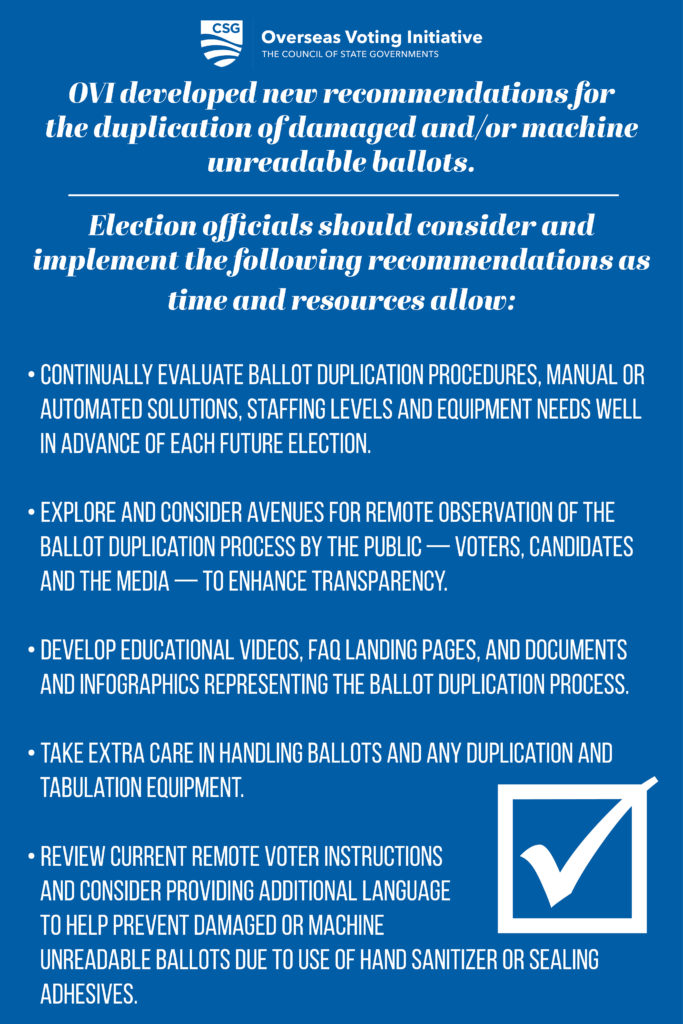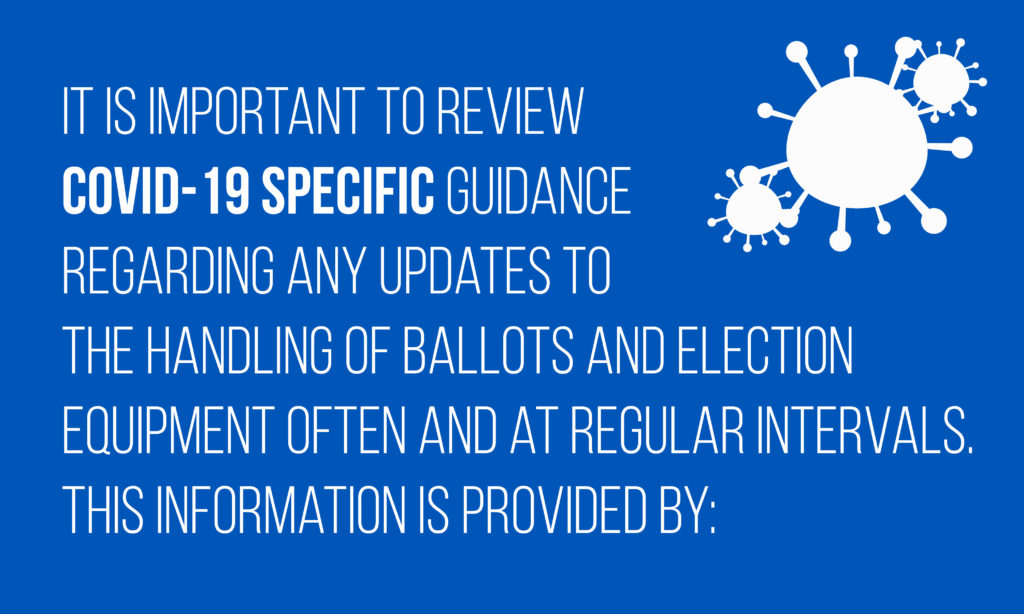With an eye toward contingency planning for Nov. 3, 2020 and beyond, the Sustainability of UOCAVA Balloting Solutions Subgroup of The Council of State Governments Overseas Voting Initiative (OVI) developed new recommendations for duplication of damaged and/or machine unreadable ballots.

Election officials should consider and implement the following recommendations as time and resources allow:
-
- Election officials should continually evaluate their ballot duplication procedures, manual or automated solutions, staffing levels and any equipment needs well in advance of each future election, noting any actionable changes or enhancements needed or desired resulting from an increase in remote ballots.
- Election officials should explore and consider avenues for remote observation of the ballot duplication process by the public — including voters, candidates and the media — to enhance transparency. For example, remote technology platforms could be used by election officials to allow for participation in or observation of the ballot duplication process and other aspects of the canvass, similar to the way they usually could in person.
- Election officials should consider developing educational videos, frequently asked questions landing pages, documents and infographics representing a jurisdiction’s ballot duplication process to help educate voters, candidates and the media about the ballot duplication process. Having this and other election administration information on hand will help jurisdictions eliminate any perceived mystery in the process while increasing understanding and transparency. These tools could be shared as part of a jurisdiction’s pre-election and post-election media and editorial board visits along with other election process and canvassing information.
-
- Election offices should take extra care in handling ballots and any duplication and tabulation equipment.
COVID-19 specific guidance provided by the U.S. Federal Voting Assistance Program, the U.S. Centers for Disease Control, the United States Postal Service and the U.S. Election Assistance Commission should be reviewed often and at regular intervals regarding any updates to the handling of ballots and election equipment- Election workers should use precautions when using hand sanitizers while handling ballots as they could accidentally smear, damage or otherwise render ballots machine unreadable.
- Election workers should use precautions to prevent damaging ballots when opening ballot envelopes as voters could use thick tape and other adhesives that jam sorters and other (envelope opening) equipment at local election offices.
- Election workers should use only technology provider-approved disinfectant and cleaning solutions on tabulation and duplication equipment to avoid damaging equipment or ballots.
- Election officials should review current remote voter instructions and consider providing additional language to help prevent damaged or machine unreadable ballots due to the use of hand sanitizer or adhesives for sealing ballot envelopes. For example, voter instructions could include the following information:
- Voters should keep all chemicals, including hand sanitizers and disinfectants, away from ballots so they do not become smeared or otherwise damaged and rendered machine unreadable upon reaching local election offices.
- In an effort to avoid “licking” ballot envelopes to seal them for mailing, voters should use water to seal ballot envelopes and not use thick tape and other adhesives that can damage ballot envelopes during opening by election staff and/or equipment.
- Election offices should take extra care in handling ballots and any duplication and tabulation equipment.
In our continuing blog series on ballot duplication, we will be expanding on some of the above recommendations, highlighting what OVI Working Group members are doing in their jurisdictions with regard to ballot duplication, sharing frequently asked questions (with answers!) on ballot duplication to aid in discussing this concept with external stakeholders, and sharing information about ballot duplication options offered by technology providers.
In our blog, “Ballot Duplication: What It is, what it is not, and why we are talking about it in 2020,”we discussed what Ballot Duplication is, what it is not and why it is important today.
Read the other articles in our Ballot Duplication series:
Ballot Duplication: What it is, what it is not and why we are talking about it in 2020
Ballot Duplication Technology: What Is It and How Does It Work?
Continued Advancement in Ballot Duplication Technology Solutions: Pilots in the Field
Contingency Planning During COVID-19: Ballot Duplication in the States
Frequently Asked Questions (and Answers) About Ballot Duplication







